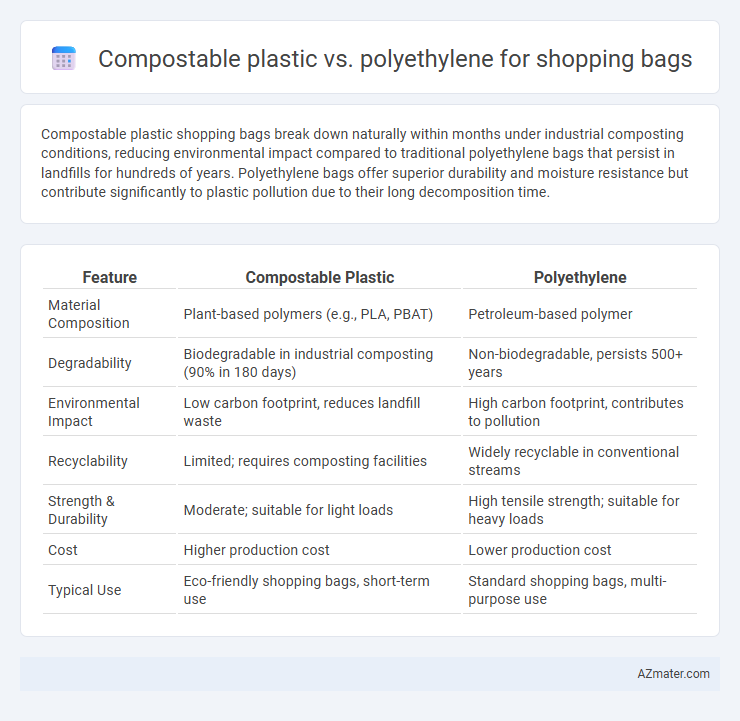Compostable plastic shopping bags break down naturally within months under industrial composting conditions, reducing environmental impact compared to traditional polyethylene bags that persist in landfills for hundreds of years. Polyethylene bags offer superior durability and moisture resistance but contribute significantly to plastic pollution due to their long decomposition time.
Table of Comparison
| Feature | Compostable Plastic | Polyethylene |
|---|---|---|
| Material Composition | Plant-based polymers (e.g., PLA, PBAT) | Petroleum-based polymer |
| Degradability | Biodegradable in industrial composting (90% in 180 days) | Non-biodegradable, persists 500+ years |
| Environmental Impact | Low carbon footprint, reduces landfill waste | High carbon footprint, contributes to pollution |
| Recyclability | Limited; requires composting facilities | Widely recyclable in conventional streams |
| Strength & Durability | Moderate; suitable for light loads | High tensile strength; suitable for heavy loads |
| Cost | Higher production cost | Lower production cost |
| Typical Use | Eco-friendly shopping bags, short-term use | Standard shopping bags, multi-purpose use |
Introduction to Shopping Bag Materials
Shopping bags are primarily made from polyethylene, a durable and cost-effective plastic derived from petroleum, widely used for its moisture resistance and strength. Compostable plastics, made from renewable plant-based materials like corn starch or polylactic acid (PLA), offer an environmentally friendly alternative designed to break down under industrial composting conditions. Understanding the material properties and environmental impact of polyethylene versus compostable plastics is crucial for making sustainable choices in shopping bag production.
Understanding Compostable Plastics
Compostable plastics, designed to break down into non-toxic components under specific composting conditions, offer an eco-friendly alternative to traditional polyethylene shopping bags, which are made from non-renewable fossil fuels and can persist in the environment for hundreds of years. Unlike polyethylene, compostable plastics are typically derived from renewable biomass sources such as cornstarch or sugarcane and comply with standards like ASTM D6400 or EN 13432, ensuring their biodegradability and safe integration into industrial composting systems. The key to understanding compostable plastics lies in recognizing their environmental benefits, including reduced greenhouse gas emissions and minimized plastic pollution, while also acknowledging their dependence on proper industrial composting infrastructure for effective degradation.
What is Polyethylene?
Polyethylene is a widely used synthetic polymer made from ethylene monomers, prized for its durability, flexibility, and cost-effectiveness in producing shopping bags. This plastic offers excellent moisture resistance and strength, making it a preferred choice for everyday use but poses environmental challenges due to its non-biodegradable nature. Unlike compostable plastics, polyethylene can persist in landfills for hundreds of years, contributing to long-term plastic pollution.
Environmental Impact of Compostable Plastics
Compostable plastics used for shopping bags break down more quickly in industrial composting facilities compared to polyethylene, reducing long-term environmental pollution and landfill volume. These materials are typically derived from renewable resources like cornstarch, which lowers fossil fuel dependence and carbon emissions during production. However, the environmental benefits depend on proper disposal and access to composting infrastructure, as compostable plastics can persist in the environment if not managed correctly.
Environmental Impact of Polyethylene
Polyethylene shopping bags contribute significantly to environmental pollution due to their non-biodegradable nature and long degradation time, often exceeding 500 years in landfills. These bags cause soil and water contamination as they release microplastics and toxic compounds during breakdown. High carbon emissions associated with polyethylene production and disposal further exacerbate global warming and ecological damage.
Durability and Performance Comparison
Compostable plastics designed for shopping bags typically degrade within 90 to 180 days under industrial composting conditions, offering limited durability compared to polyethylene bags that can withstand heavy loads and resist punctures or tears. Polyethylene bags provide superior tensile strength, flexibility, and water resistance, ensuring reliable performance during repeated use and transportation of goods. While compostable bags reduce environmental impact post-use, polyethylene remains the preferred option in scenarios demanding high durability and consistent performance.
Decomposition Rates and Processes
Compostable plastic shopping bags typically decompose within 90 to 180 days under industrial composting conditions, breaking down into water, carbon dioxide, and biomass through microbial activity. Polyethylene bags, composed of long-chain hydrocarbons, can persist for hundreds of years in landfills or the environment, decomposing primarily through slow photodegradation and fragmentation into microplastics. The rapid biodegradation of compostable plastics contrasts sharply with the prolonged environmental persistence and pollution risks associated with polyethylene bags.
Cost Analysis: Compostable vs Polyethylene Bags
Compostable shopping bags typically cost 20-40% more per unit than polyethylene bags due to higher raw material and production expenses. Polyethylene bags benefit from mass production efficiencies and lower material costs, making them the more economical choice for retailers. However, long-term environmental savings from compostable bags may offset initial higher costs in sustainable business models.
Consumer Perceptions and Market Trends
Consumers increasingly favor compostable plastics for shopping bags due to environmental concerns, perceiving them as more sustainable compared to traditional polyethylene bags, which are often criticized for their long degradation period and contribution to plastic pollution. Market trends reveal a significant rise in demand for compostable bags, driven by stricter regulations, growing eco-consciousness, and retail shifts toward biodegradable packaging solutions. Despite higher costs associated with compostable plastics, consumer willingness to pay a premium aligns with the expanding availability and branding of sustainable shopping alternatives.
Choosing the Right Shopping Bag for Sustainability
Compostable plastic shopping bags, made from plant-based materials like PLA or starch blends, break down naturally within months under industrial composting conditions, reducing long-term environmental impact. Polyethylene bags, derived from fossil fuels, persist in landfills and oceans for decades, contributing significantly to pollution and wildlife harm. Opting for compostable bags supports circular economy goals by minimizing plastic waste and promoting sustainable disposal, making them the preferred choice for eco-conscious consumers and retailers aiming to reduce carbon footprints.

Infographic: Compostable plastic vs Polyethylene for Shopping bag
 azmater.com
azmater.com